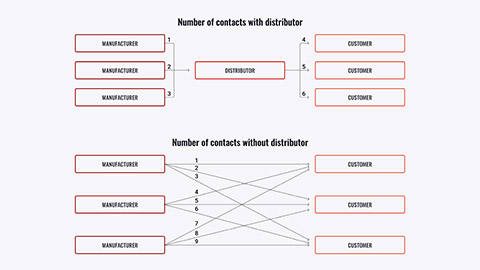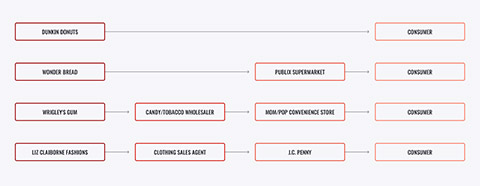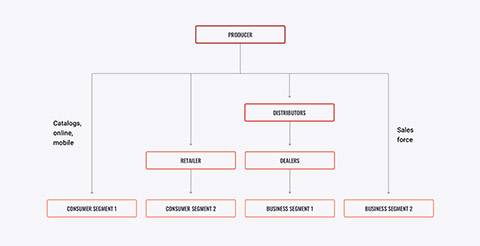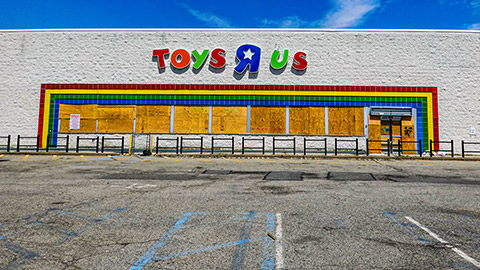Welcome to Distribution. In this topic, you will learn about:
- Distribution channels and their function
- Ethics within distribution channels
- Direct and indirect distribution channels
- Key types of intermediaries
- Vertical marketing system
- Horizontal marketing system
- Multichannel distribution systems
- Conventional distribution channel versus vertical marketing system
Distribution channels in marketing represent one of the 4 P’s, placement, i.e. distribution. Companies and service providers implement distribution channels in order to ensure their product or service flows through from creating to manufacturing and pricing and out the door ready to be presented on store shelves or websites for customers to be able to access.
A distribution channel is a pathway, typically in the form of chains of businesses or intermediaries (links within the chain), facilitates the movement of a product from a producer to a final consumer. At a minimum, a distribution channel would typically consist of a producer (or manufacturer/creator of a product or service), and a customer.
Distribution channels can either be direct or indirect.
A direct channel would see the manufacturer or service provider selling their service or product directly to the end-user, no middleman or intermediary, this is the simplest form of distribution.
An indirect channel would have more than one middleman or intermediary who facilitate the movement of goods between the producer and the consumer or end-user. Examples of intermediaries would be: Agents, wholesalers, distributors, and retailers.
Place-channel strategy

Within a typical channel design, a supplier would have four-channel options to be able to reach its customers. They could opt to work with a wholesaler which would then supply the retailer and then serve the end-users, the customers. Alternatively, the supplier could opt to work with an agent such as a broker rather than a retailer and then through a retailer. Thirdly, the supplier could work directly with the retailer or lastly, and simply, supply directly to its end customers.
How a distributor reduces the number of channel transactions

The above figure shows how using intermediaries can provide economies.
- Part A shows three manufacturers, each using direct marketing to reach three customers. This system requires nine different contacts.
- Part B shows the three manufacturers working through one distributor, which contacts the three customers. Utilizing one distributor requires only six contacts and reduces the amount of work that must be done by both producers and consumers.
Members of the marketing channel perform many key functions. Some function help to complete transactions:
Key functions performed by channel members
- Information: gathering and distributing information about consumers, producers, and other actors and forces in the marketing environment needed for planning and aiding exchange.
- Promotion: developing and spreading persuasive communications about an offer
- Contact: finding and engaging customers and prospective buyers
- Matching: shaping offers to meet the buyer’s needs, including activities such as manufacturing, grading, assembling, and packaging
- Negotiation: reaching an agreement on price and other terms so that ownership or possession can be transferred.
Other functions performed to help to fulfil the completed transactions
- Physical distribution: transporting and storing goods
- Financing: acquiring and using funds to cover the costs of the channel work
- Risk-taking: assuming the risks of carrying out the channel work.
Evolution of distribution functions
The Internet has evened the playing field for small firms with limited resources by making it possible for them to reach a national, if not international audience. While this is great news for entrepreneurs, e-commerce has radically impacted distribution strategies for a variety of goods and services.
If intermediaries fail to provide unique value, they are at risk of disintermediation. Goods that are sold over the Internet allow manufacturers to reduce costs by eliminating many of the intermediaries traditionally found in offline channels of distribution, an outcome which has been called disintermediation. For example, airlines no longer need traditional travel agencies to book flights for consumers—consumers book their own flights either through online mega travel agencies such as Expedia, or directly from the airline’s website, eliminating the commission fee paid to booking agents. Additional forms of cost reduction come from fewer employees, and less need for “brick and mortar” company-owned stores (and all the costs that go with them). The elimination of some layers of the channel of distribution to cut costs and improve the efficiency of the channel.
Online distribution

The Internet is radically changing how companies coordinate among members of a supply chain to make it more effective in ways that consumers never see. These firms develop better ways to implement knowledge management, which refers to a comprehensive approach that collects, organizes, stores, and retrieves a firm’s information assets. Such assets include databases and company documents as well as the practical knowledge of employees whose past experience may be relevant to solve a new problem.
In the world of B2B, this process probably occurs via an intranet (Ch. 6), which is an internal corporate communication network that uses Internet technology to link company departments, employees, and databases. But it can also be used to facilitate sharing of knowledge among channel partners since it is a secure and password-protected platform.
However, the Internet as a distribution channel is not without potential problems. One of the more vexing issues with Internet distribution is the potential for online distribution piracy, which is the theft and unauthorized repurposing of intellectual property via the Internet. For instance, unauthorized downloads of music continue to pose a major challenge to the “recording” industry—to the point where the whole nature of the industry has turned topsy-turvy in search of a new business model that works.
Companies’ decisions about how to make their products available to consumers through distribution channels can create ethical dilemmas.
For example, of large intermediaries like Wal-Mart can have detrimental effects on smaller retailers because their size gives them great bargaining power when they negotiate with manufacturers, many large retail chains force manufacturers to pay a slotting allowance—a fee in exchange for agreeing to place a manufacturer’s products on a retailer’s valuable shelf space. Although retailers claim that such fees help pay the cost of adding products to their inventory, many manufacturers feel that slotting fees are more like highway robbery. In addition, the practice prevents many smaller manufacturers that cannot afford the slotting allowances from getting their products into the hands of consumers.
Product diversion is a problem for manufacturers because it might mean that the product is selling for a price different than what is expected, or the product may have been altered or tampered with.
Channel conflict: Disagreements among marketing channel members on goals, roles, and rewards.
- Horizontal conflict occurs among firms at the same level of the channel.
- Vertical conflict occurs between different levels of the same channel.

As previously explained, consumer channels of distributions can take a variety of forms, including direct from the producer to the consumer, or one which includes one or more wholesalers and retailers. The above image provides an example of typical consumer channels.
Direct channels often allow producers to serve customers better and at a lower cost. Sometimes this is the only option because using intermediaries may inflate the final price to the consumer beyond what he or she is willing to pay. Direct channels also provide manufacturers with more control over the pricing, service, and delivery process. Working directly with consumers may also provide valuable insights into trends, needs, complaints, and the effectiveness of various marketing strategies.
Producers are often forced to use indirect channels to reach consumers at the places they prefer to shop and expect to find merchandise of certain types. The producer-retailer-consumer channel creates utility and transaction efficiencies, channel members enhance the ability of producers to reach customers.
The producer-wholesaler-retailer-consumer channel is very common in consumer marketing of products such as ice cream as well as fashion products.
Distribution channels and the marketing mix
Channel decisions, i.e. placement, impact other elements of the marketing mix, the remining 3 P’s. Pricing objectives and strategies will vary based on channel member selection therefore a distribution channel may help position a product in a unique way. See below how Amazon and Netflix have incorporated this into their marketing and adapted in response to a changing environment.
Time and again, Netflix has innovated its way to the top in the distribution of video entertainment. But to stay atop its boiling, roiling industry, Netflix must keep the distribution innovation pedal to the metal.
Netflix did not pioneer digital streaming, it poured resources into improving the technology and building the largest streaming content library. It built a huge subscriber base, and sales and profits soared. With its massive physical DVD library and a streaming library of more than 20,000 high-definition movies accessible via 200 different devices, it seemed that nothing could stop Netflix.
To stay ahead, even to survive the competition, Netflix needed to innovate. So, in the summer of 2011, in an ambitious but risky move, CEO Hastings made an all-in bet on digital streaming. He split off Netflix’s still-thriving DVD-by-mail service into a separate business with a separate subscription fee. On an average weeknight, Netflix commands one-third of all internet traffic in North American homes and the company has expanded globally into more than 190 countries. Streaming now accounts for nearly all of Netflix’s fast-growing revenues.
Intermediaries are the businesses that provide a service that helps the company to promote, sell and distribute its products to final buyers. Channels of distribution contain both wholesalers and retailers of course; however, here we will focus on wholesaling.
Wholesaling intermediaries are firms that handle the flow of products from the manufacturer to the retailer/business user.
Below shows two branches of intermediaries.

Independent intermediaries do business with many different manufacturers and many different customer firms and thus help the flow of goods throughout the marketplace.
- Merchant wholesalers are independent intermediaries that buy goods from manufacturers and sell to retailers and other B2B organizations. Because they take title to goods (meaning they take legal ownership of the items), they assume risk and can suffer financial losses if the products are damaged while in their possession, or if they become obsolete or just don’t sell. There are several forms of merchant wholesalers as shown in the next slide.
- Merchandise agents or brokers are independent intermediaries that provide service in exchange for commissions but never take title to the product. Sometimes they don’t even take physical possession of the product. Agents normally represent buyers or sellers on an ongoing basis whereas brokers are normally employed by clients for only a short period of time.
Manufacturer-owned intermediaries are separate business units that perform all the functions of independent intermediaries while still maintaining complete control over the channel.
Let us look at each of these intermediary types in greater detail.
Merchant wholesalers
Full-service merchant wholesalers provide delivery, credit, repairs, advertising market research and more to their customers, and often field their own sales force. General merchandise wholesalers (such as a food wholesaler) carry a wide variety of different items, whereas specialty wholesalers (such as a candy wholesaler) carry a deep assortment of items within a specific product line.
By contrast, limited-service merchant wholesalers provide fewer services to their customers, and include the cash-and-carry wholesaler, truck jobbers, drop shippers, mail-order wholesalers, and rack jobbers, each of which is described below.
- Cash-and-carry wholesalers provide products for small-business customers and are used to distribute low-cost merchandise for small retailers and other business customers.
- Truck jobbers deliver perishable food and tobacco items to retailers (e.g., those that deliver bread to stores)
- Drop shippers take orders from retailers and bill retailers for bulky items that are drop-shipped from the manufacturer
- Mail-order wholesalers sell through the phone, via mail order, or catalogues and thus provide reasonably priced items to smaller organizational customers (e.g., Granger, Harbor Tools
- Rack jobbers provide display units to retailers, check inventories, and stock shelves.
Limited-service wholesalers also take title to the merchandise, but are less likely to offer delivery, credit, or marketing assistance.
Merchandise agents or brokers
Merchandise agents or brokers are channel intermediaries that provide service in exchange for commissions but never take title to the product. Sometimes they do not even take physical possession of the product. Agents normally represent buyers or sellers on an ongoing basis whereas brokers are normally employed by clients for only a short period of time. The various forms of merchandise agents and brokers are listed and explained below.
- Manufacturers’ agents use independent salespeople to promote several lines of noncompeting products.
- Selling agents, particularly import/export agents market a whole product line or one manufacturer’s entire output.Their value rests in the fact that they are capable of providing all marketing functions for small manufacturers.
- Commission merchants, as the name suggests, sell products on a commission basis and are best used in agricultural markets.
- Merchandise brokers do not take physical possession of the good, but rather identify buyers and sellers and get them together, creating efficiencies in marketers in which many small buyers and sellers exist. (e.g., wineries and wine distributors)
Manufacturer-owned intermediaries
Producers may set up their own channel intermediaries which perform functions of independent intermediaries while maintaining control, for example:
- Sales branches are manufacturer-owned facilities that, like independent wholesalers, carry inventory and provide sales and service to customers in a specific geographic area.
- Sales offices are manufacturer-owned facilities that, like agents, do not carry inventory but provide selling functions for the manufacturer in a specific geographic area. Allow members of the sales force to locate close to customers, reducing selling costs and offering better customer service.
- Manufacturers’ showrooms are manufacturer-owned or leased facilities in which products are permanently displayed for customers to visit. Retailers can visit either during a trade show or all year long to see the manufacturer’s merchandise and make B2B purchases.
A vertical marketing system, (or VMS), is simply a channel in which members at different levels (hence the term ‘vertical’) work together in a unified way in order to accomplish the work of the channel, typically this occurs via formal cooperation among members at two or more levels.
Let us look further into three different types of vertical marketing systems.
- Administered VMS
- Corporate VMS
- Contractual VMS
In an administered VMS, channel members remain independent but voluntarily work together because of the power of a single channel member. Strong brands can manage an administered VMS because resellers are eager to work with the manufacturer so they will be allowed to carry the product.
In a corporate VMS, a single firm owns manufacturing, wholesaling, and retailing operations. Thus, the firm has complete control over all channel operations. Retail giant Macy’s, for example, owns a nationwide network of distribution centres and retail stores.
In a contractual VMS, cooperation is enforced by contracts (legal agreements) that spell out each member’s rights and responsibilities and how they will cooperate. Three types of contractual VMS are most common:
- In a wholesaler-sponsored VMS, wholesalers get retailers to work together under their leadership in a voluntary chain. Retail members of the chain use a common name, cooperate in advertising and other promotion, and even develop their own private-label products. Examples of wholesaler-sponsored chains are IGA (Independent Grocers’ Alliance) food stores and Ace Hardware stores.
- A retailer cooperative is a group of retailers that establishes a wholesaling operation to help them compete more effectively with the large chains. Each retailer owns shares in the wholesaler operation and is obligated to purchase a certain percentage of its inventory from the cooperative operation. Associated Grocers and True Value Hardware stores are examples of retailer cooperatives.
- Franchise organizations are a third type of contractual VMS. Franchise organizations include a franchiser (a manufacturer or a service provider) who allows an entrepreneur (the franchisee) to use the franchise name and marketing plan for a fee. In these organizations, contractual arrangements explicitly define and strictly enforce channel cooperation. Usually, the franchisees are obligated to follow the franchiser’s business format very closely to maintain the franchise.
What is a horizontal marketing system?
In a horizontal marketing system, two or more firms at the same channel level agree to work together to get their product to the customer. Sometimes, unrelated businesses forge these agreements. A good example of a horizontal marketing systems is airline code-sharing.
Most airlines today are members of a horizontal alliance that allows them to cooperate when they provide passenger air service. For example, American Airlines is a member of the OneWorld alliance, which also includes Air Berlin, British Airways, Cathay Pacific, Finnair, Iberia, Japan Airlines, LAN, Malaysia Airlines, Qantas, Qatar Airways, Royal Jordanian, S7 Airlines, SriLankan Airlines, TAM Airlines and, recently added, US Airways.
These alliances increase passenger volume for all airlines because travel agents who book passengers on one of the airline’s flights will be more likely to book a connecting flight on the other airline. To increase customer benefits, they also share frequent-flyer programs and airport clubs.
- American Airlines
- British Airways
- Cathay Pacific
- Finnair
- Iberia
- Japan Airlines
- Malaysia,
- Qantas
- Qatar
- Royal Air Maroc
- Royal Jordanian
- S7 Airlines
- SriLankan Airlines
- Fiji Airways
- Alaska Airlines.
- Aegean
- Air Canada
- Air China
- Air New Zealand
- ANA
- Asiana Airlines
- Austrian
- Avianca
- Brussels airlines
- Copa Airlines
- Croatia Airlines,
- EgyptAir
- Ethiopian Airlines
- Eva Air
- Juneyao Airlines
- LOT Polish Airlines
- Lufthansa
- SAS
- Shenzhen Airlines
- Singapore Airlines
- South African Airways
- SWISS
- TAP Portugal
- THAI
- Turkish Airlines
- United Airlines
- Aeroflot
- Aerolíneas Argentinas
- Aeroméxico
- Air Europa
- Air France
- Alitalia
- China Airlines
- China Eastern,
- Czech Airlines
- Delta Airlines
- Garuda Indonesia
- Kenya Airlines
- KLM
- Korean Air
- Middle East Airlines
- Saudia Airlines
- TAROM
- Vietnam Airlines
- Xiamen Air
What is a multichannel distribution system?

Almost every large company and many small ones distribute through multiple channels. A multichannel distribution system refers to a single firm that sets up two or more marketing channels to reach one or more customer segments. For example, you could buy a John Deere tractor from a local John Deere dealer of from Lowe’s. A larger form or forestry business would buy larger John Deere equipment from a premium full-service John Deere dealer and its sales force.
Multichannel distribution systems offer many advantages to companies facing large and complex markets. With each new channel, the company expands its sales and market coverage and gains opportunities to tailor its products and services to the specific needs of diverse customer segments. But such multichannel systems are harder to control, and they can generate conflict as more channels compete for customers and sales.
Disintermediation

Disintermediation occurs when product or service producers cut out marketing channel intermediaries or when radically new types of channel intermediaries displace traditional ones.
Toys “R” Us pioneered the superstore format that once made it the go-to place for buying toys and baby products, driving most small independent toy stores out of business. What Toys “R” Us failed to do was adapt to major shifts in toy market sales, first toward big discounters such as Walmart and Target and then toward online merchants like Amazon, as a result, Toy “R” Us recently closed down operations and shuttered its stores.

A conventional distribution channel consists of one or more independent producers, wholesalers, and retailers. Each is a separate business seeking to maximize its own profits, perhaps even at the expense of the system as a whole. No channel member has much control over the other members, and no formal means exists for assigning roles and resolving channel conflict.
In contrast, a vertical marketing system (VMS) consists of producers, wholesalers, and retailers acting as a unified system. One channel member owns the others, has contracts with them, or wields so much power that they must all cooperate.
End of topic forums
There are forum activities for this topic. Select the ‘Forum’ at the end of your module (which can be found within your navigation menu) and follow the instructions for each question pertaining to 9 within the forum.
Read the following articles:
Supply chain of the future: Key principles in building an omni-channel distribution network
Building a Direct-to-Consumer Strategy Without Alienating Your Distributors.
How consumer companies in China are preparing for the next normal: A virtual roundtable
Amazon Has “Destroyed The Retail Industry”: True Or False?

